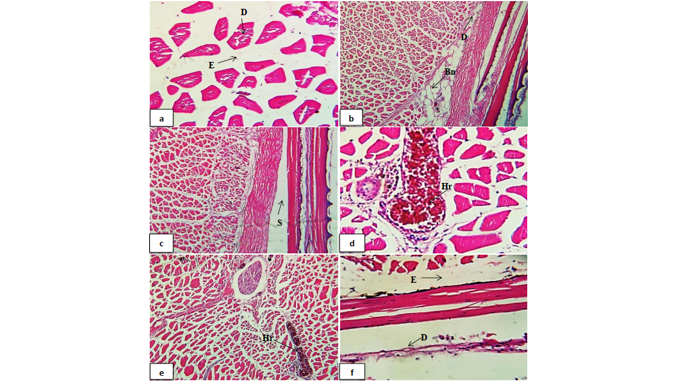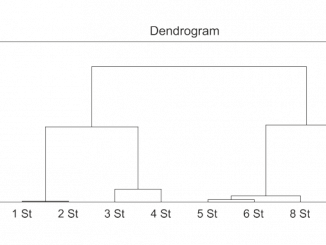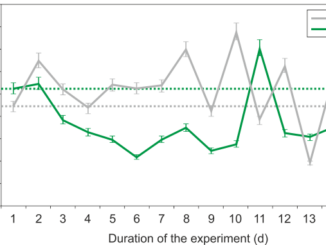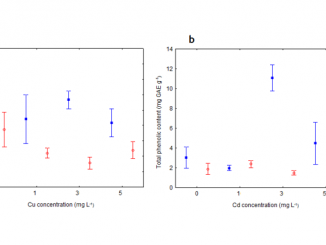
Paper category: Original research paper
Corresponding author: Amaal M. Abdel-Satar (abdelsatarmena11@yahoo.com)
DOI: 10.2478/oandhs-2021-0001
Received: 26/07/2020
Accepted: 02/10/2020
Full text: here
Citation (APA style): Yacoub, A., Mahmoud, S. & Abdel-Satar, A. (2021). Accumulation of heavy metals in tilapia fish species and related histopathological changes in muscles, gills and liver of Oreochromis niloticus occurring in the area of Qahr El-Bahr, Lake Al-Manzalah, Egypt. Oceanological and Hydrobiological Studies, 50(1), 1-15. https://doi.org/10.2478/oandhs-2021-0001
Abstract
Accumulation of metals (Fe, Zn, Cu, Mn, Pb, Cd and Ni) in the muscles and gills of Oreochromis niloticus, Oreochromis aureus and Tilapia zillii was assessed based on seven locations in the Qahr El-Bahr area in Lake Al-Manzalah. The average accumulation of metals was in the following order: Tilapia zillii > Oreochromis aureus > Oreochromis niloticus. To determine the risk of fish consumption, the estimated daily intake, carcinogenic, non-carcinogenic and relative risk indices were calculated. The results indicate that the intake of individual metals through the consumption of fish is almost safe for human health, whereas the intake of combined metals poses a high potential health risk to consumers. Assessment of carcinogenic risk of Cd and Ni from the consumption of tilapia species indicates that consumers are at risk of cancer. The contribution of Pb and Cd to the overall relative risk index ranged from 34% to 41%. Of the three species studied, Oreochromis niloticus is relatively safe for consumption as it poses the least health hazard, while Tilapia zillii is more predisposed to accumulate metals in its tissues. Histopathological changes were observed in the muscles, gills and liver of Oreochromis niloticus as a result of heavy metal accumulation in these organs.
Conclusions
The study showed that tilapia fish species caught in the area of Qahr El-Bahr in Lake Al-Manzalah contained varying concentrations of metals and the degree of their accumulation varied among different tilapia species. The average level of heavy metals ranged as follows: Tilapia zillii > Oreochromis aureus > Oreochromis niloticus. The accumulation rate of heavy metals in the muscles and gills of tilapia fishes were in the following order; Fe > Zn > Ni > Mn > Cu > Pb > Cd. The studied metals do not pose carcinogenic health hazards individually but their combined effects are potentially hazardous to the health of consumers (HP > 1). The muscles of Oreochromis niloticus occurring in the Qahr El-Bahr area of Lake Al-Manzalah are almost safe for human consumption. Thus, Oreochromis niloticus can withstand the risk of heavy metals in the study area. In general, a moderate intake of tilapia fish from Lake Al-Manzalah is strongly recommended for consumers to avoid serious health problems, including cancer and kidney malfunctions. Histopathological changes, including degeneration, fatty degeneration, necrosis, edema, hemorrhage, hemolysis, hemosiderin, curling and hyperplasia were found in the muscles, gills and liver of Oreochromis niloticus due to the accumulation of heavy metals in fish organs.
References
Abarshi, M.M., Dantala, E.O. & Mada, S.B. (2017). Bioaccumulation of heavy metals in some tissues of croaker fish from oil spilled rivers of Niger Delta region, Nigeria. Asian Pac. J. Trop. Biomed. 7(6): 563–568.
Abdel-Satar, A.M. & Goher, M.E. (2009). Nutrient status and phosphorus speciation of Manzalah Lake sediment, Egypt. Thalassia Salentina 32: 3–16.
Abdel-Satar, A.M. (2001). Environmental studies on the impact of the drains effluent upon the southern sector of Lake Manzala, Egypt. Egypt. J. Aquat. Biol. & Fish. 5(3): 17–30.
Abdel-Satar, A.M. (2008). Chemistry of major ions, nutrient salts and heavy metals in the Manzalah Lake system, Egypt. Egypt. J. Aqua. Res. 34(2): 130–148.
Abdel-Satar, A.M., Geneid, Y.A. (2009). Evaluation of heavy metal status in ecosystem of Lake Manzalah, Egypt. Global. J. Environ. Res. 3(3): 194–204.
Abdel-Satar, A.M.; Ali, M.H.H & Goher, M.E. (2017). Distribution and speciation of Fe, Mn, Zn, Cu, Pb and P in surface sediments of Mariut Lake, Egypt. Oceanological and Hydrobiological Studies 46(2): 154–167.
Abou El-Gheit, E.N., Abdo, M.H. & Mohmoud, S.A. (2012). Impact of blooming phenomenon on water quality and fishes in Qarun Lake, Egypt. International Journal of Environmental Science and Engineering (IJESE) 3: 11–23.
Abu Khatita, A.M., Shaker, I.M. & Shetaia, S.A. (2015). Urabanization and human activities around Manzala Lake, Egypt: studies on heavy metals distribution and environmental impacts. Sedimentology of Egypt 22: 69–83.
Ahmed, M., Donia, N. & Fahmy, M. (2006). Eutrophication assessment of Lake Manzala, Egypt using geographical information systems (GIS) techniques. Journal of Hydroinformatics 8(2): 101–109.
Ahmed, Md.K., Abdul Baki, M., Kundu, G.K., Islam, Md.S., Islam, Md.M. et al. (2016). Human health risks from heavy metals in fish of Buriganga River, Bangladesh. SpringerPlus 5: 1697.
Ali, M.M., Ali, M.L., Proshad, R., Islam, S., Rahman, Z. et al. (2019). Heavy metal concentrations in commercially valuable fishes with health hazard inference from Karnaphuli river, Bangladesh. Human and Ecological Risk Assessment: An International Journal DOI: 10.1080/10807039.2019.1676635.
Ali, M.M.H. (2008). Assessment of some water quality characteristics and determination of some heavy metals in Lake Manzala, Egypt. Egypt. J. Aquat. Biol. & Fish. 12(2): 133–154.
Alvarado, N.E., Quesada, K., Hylland, I., Marigómez, L. & Soto, M. (2006). Quantitative changes in metallothionein expression in target cell-types in the gills of turbot (Scophthalmus maximus) exposed to Cd, Cu, Zn and after a depuration treatment. Aquatic Toxicology 77(1): 64–77.
Al-Yousuf, M.H., El-Shahawi, M.S. & Al-Ghais, S.M. (2000). Trace metals in liver, skin and muscle of Lethrimus lentjan fish species in relation to body length and sex. The Science of the Total Environment 256(2–3): 87–94.
Atique Ullah, A.K.M., Maksud, M.A., Khan, S.R., Lutfa, L.N. & Quraishi, S.B. (2017). Dietary intake of heavy metals from eight highly consumed species of cultured fish and possible human health risk implications in Bangladesh. Toxicology Reports 4: 574–579.
Authman, M. & Abbas, H. (2007). Accumulation and distribution of copper and zinc in both water and some vital tissues of two fish species (Tilapia zillii and Mugil cephalus) of Lake Qarun, Fayoum Province, Egypt. Pak. J. Biol. Sci. 10(13): 2106–2122.
Bayomy, M.F.F. & Tayel, S.I. (2007). Effect of industrial wastes on the bony fish Clarias gariepinus inhabiting the River Nile (Egypt). J. Egypt. Ger. Soc. Zool. 54C: 239–255.
Clarke, M.L., Harvey, D.G. & Humphreys, D.J. (1981). Veterinary Toxicology. London: Bailliere Tindall
Dalzochio, T., Rodrigues, G., Simões, L.A., de Souza, M., Petry, I.E. et al. (2018). In situ monitoring of the Sinos River, southern Brazil: water quality parameters, biomarkers, and metal bioaccumulation in fish. Environ. Sci. Pollut. Res. Int. 25: 9485–9500.
Dave, G & Xiu, R (1991). Toxicity of mercury, copper, nickel, lead and cobalt to embryos and larval of Zebra fish Brachydanio rerio. Archive of Environmental Contamination and Toxicology 21: 126–134.
Dimari, G.A., Abdulrahman, J.C. & Garba, S.T. (2008). Metals concentrations in tissues of Tilapia gallili, Clarias lazera and Osteo glossidae caught from Alau Dam, Maiduguri, Borno State, Nigeria. American Journal of Environmental Sciences 4(4): 373–379.
El-Bokhty, E.E.B .(2010). Fisheries management of Oreochromis niloticus and Oreochromis aureus caught by Trammel Nets and Basket Traps in Lake Manzalah, Egypt. World Journal of Fish and Marine Sciences 2(1): 51–58.
Elewa, A.A., Saad, E.A., Shehata, M.B. & Ghallab, M.H. (2007). Studies on the effect of drain effluents on the water quality of Lake Manzala, Egypt. Egypt. J. Aquat. Biol. & Fish. 11(2): 65–78.
Elmorsi, R.R., Abou-El-Sherbini, K.S., Mostafa, G.A. & Hamed, M.A. (2019) Distribution of essential heavy metals in the aquatic ecosystem of Lake Manzala, Egypt. Heliyon 5(8): e02276.
Elnabris, K.J., Muzyed, S.K. & El-Ashgar, N.M. (2013). Heavy metal concentrations in some commercially important fishes and their contribution to heavy metals exposure in Palestinian people of Gaza Strip (Palestine). Journal of the Association of Arab Universities for Basic and Applied Sciences 13(1): 44–51.
El-Naggar, A.M., Mahmoud, S.A. & Tayel, S.I. (2009). Bioaccumulation of some heavy metals and histopathological alterations in liver of Oreochromis niloticus in relation to water quality at different localities along the River Nile, Egypt. World J. Fish. & Marine Sci. 1(2): 105–114.
El-Naggar, N., Rifaat, A.E. & Khalil, M.Kh. (2016) Numerical modeling on water flow in Manzala Lake, Nile Delta, Northern Egypt. International Journal of Contemporary Applied Sciences 3(4): 28–44.
El-Refaie, Gh. (2010) Temperature impact on operation and performance of Lake Manzala Engineered Wetland, Egypt. Ain Shams Engineering Journal 1(1): 1–9.
El-Serafy, S.S., Ibrahim, S.A. & Mahmoud, S.A. (2005). Biochemical and histopathological studies on the muscles of the Nile Tilapia (Oreochromis niloticus) in Egypt. Egypt. J. Aquatic. Biol. & Fish. 9(1): 81–96.
EL-Shafei, H.M. (2016). Assessment of some water quality characteristics as guidelines for the management of pond fish culture in Lake Manzala, Egypt. International Journal of Fisheries and Aquatic Studies 4(2): 416–420.
FAO (Food and Agricultural Organization). (1983). Compilation of legal limits for hazardous substances in fish and fishery products, FAO Fishery Circular No. 464, pp. 5–100.
FAO (Food and Agricultural Organization). (2014). Report of fisheries and aquaculture markets in the Middle East. (http://www.thefishsite.com/articles/1870/fao-report-fisheries-and-aquaculture markets-in-the-middle-east).
FAO/WHO (Food and Agricultural Organization/World Health Organization). (2011). Food Standards Programme Codex Committee on Contaminants In Foods Fifth Session. The Hague, The Netherlands, 21–25 March 2011.
Fatima, M., Usmani, N., Firdaus, F., Zafeer, M.F., Ahmad, S. et al. (2015). In vivo induction of antioxidant response and oxidative stress associated with genotoxicity and histopathological alteration in two commercial fish species due to heavy metals exposure in northern India (Kali) river. Comparative Biochemistry and Physiology, Part C 176–177: 17–30.
Fernandes, C., Fernandes, A.F., Ferreira, M. & Salgado, M. (2008). Oxidative stress response in gill and liver of Liza saliens, from the Esmoriz-Paramos coastal lagoon, Portugal. Arch. Environ. Contam. Toxicol. 55: 691–700.
Gaber, H.S. & Gaber, S.A. (2006). The effect of water quality of Lake Quarun on liver and gonads of Oreochromis aureus (L.) and Tilapia zillii (Gev.). Egypt. J. Aquat. Res. 32(2): 335–349.
Goher, M.E., Abdo, M.H., Bayoumy, W.A. & Mansour, El-Ashkar T.Y. (2017). Some heavy metal contents in surface water and sediment as a pollution index of El-Manzala Lake, Egypt. Journal of Basic and Environmental Sciences 4: 210–225.
Goldberg, E.D., Koide, M., Hodge, V., Flegal, A.R. & Martin, J. (1983). U.S. mussel watch: 1977–1978 results on trace metals and radionuclides. Estuarine, Coastal and Shelf Science 16(1): 69–93.
Hamed, Y.A., Abdelmoneim, T.S., ElKiki, M.H., Hassan, M.A. & Berndtsson, R. (2013). Assessment of heavy metals pollution and microbial contamination in water, sediments and fish of Lake Manzala, Egypt. Life Sci. J. 10(1): 86–99.
Hashem, M.H., Tayel, S.I., Sabra, E.A., Yacoub, A.M. & Heiba, A.A. (2020). Impact of the water quality of El-Rahawy Drain on some genetic and histopathological aspects of Oreochromis niloticus. Egypt J. Aquat. Biol. & Fish. 24(2): 19–38.
Hegazy, W.H., Hamed, M.A., Toufeek, M.E.S. & Mabrouk, B.K.A. (2016). Determination of some heavy metals in water of the southern region of Lake Manzlah, Egypt. Egypt. J. Aquat. Biol. & Fish. 20(4): 69–81.
Hossen, H. & Negm, A. (2016). Performance of water bodies extraction techniques “embedded in ERDAS”: Case Study Manzala Lake, Northeast of Nile Delta, Egypt. Nineteenth International Water Technology Conference, IWTC19 Sharm ElSheikh, 21–23 April 2016 50.
IARC (International Agency for Research on Cancer). (2012). Monographs on the evaluation of carcinogenic risks to humans: chemical agents and related occupations. A review of human carcinogens. Lyon, France: International Agency for Research on Cancer 100F: 224–248.
Ibrahim, S.A. & Mahmoud, S.A. (2005). Effect of heavy metals accumulation on enzyme activity and histology in liver of some Nile fish in Egypt. Egypt. J. Aquat. Biol. & Fish. 9(1): 203– 219.
Islam, Md.S., Ahmed, Md.K. & Habibullah-Al-Mamun, Md. (2017). Heavy metals in sediment and their accumulation in commonly consumed fish species in Bangladesh. Archives of Environmental & Occupational Health 72(1): 26–38.
Kadry, S.M., Tayel, S.I., Afify, M.F.H. & El-Sayed, R.A. (2015). Eco-histopathological studied on Oreochromis niloticus fish living in Damietta Branch in Egypt. World Journal of Pharmaceutical Sciences 3(5): 815–825.
Kumari, U., Mittal, S. & Mittal, A.K. (2012). Surface ultrastructure of the gill filaments and the secondary lamellae of the catfish, Rita rita, and the carp, Cirrhinus mrigala. Microsc. Res. Tech. 75: 433–440.
Mahboob, S., Al-Ghanim, K.A., Al-Balawi, H.F., Al-Misned, F. & Ahmed, Z. (2020). Toxicological effects of heavy metals on histological alterations in various organs in Nile tilapia (Oreochromis niloticus) from freshwater reservoir. Journal of King Saud University- Science 32(1): 970–973.
Mahmoud, S.A. & Abd El Rahman, A.A. (2017). Eco- Toxicological studies of water and their effect on fish in El Manzalah Lake. Research Journal of Pharmaceutical, Biological and Chemical Sciences 8: 2497–2511.
Mahmoud, S.A. & El-Naggar, A.M. (2007). Alterations in Clarias gariepinus caused by pollutants at El-Rahawy area, Rosetta branch, River Nile, Egypt. J. Egypt. Acad. Environ. Develop. 8(2): 61–70.
Mallatt, J. (1985). Fish gill structural changes induced by toxicants and other irritants: a statistical review. Canadian Journal of Aquatic Science 42: 630–648.
Marcogliese, D.J., Blaise, C., Cyr, D., de Lafontaine, Y., Fournier, M. et al. (2015). Effects of a major municipal effluent on the St. Lawrence River: a case study. AMBIO 44: 257–274.
Markmanuel, D.P. & Horsfall, Jnr M. (2016). Evaluation of carcinogenic and non-carcinogenic risk of cadmium and nickel in land snails (A. achatina and L. flammea) and marine snails (P. aurita and T. fuscatus) commonly consumed in Nigeria. Acta Chim. Pharm. Indica 6(4): 123–134.
Mehanna, S.F., Shaker, I.M. & Farouk, AE-d. (2014). Impacts of excessive fishing effort and heavy metals pollution on the Tilapia production from Lake Manzalah. In: 4th Conference of Central Laboratory for Aquaculture Research (57–74): Egypt.
Mela, M.R., Ventura, F., Carvalho, D.F., Pelletier, C.E. & Ribeiro, C.A. (2007). Effects of dietary methylmercury on liver and kidney histology in the neotropical fish Hoplias malabaricus. Ecotoxicology and Environmental Safety 68(3): 426–435.
Miri, M., Akbari, E., Amrane, A., Jafari, S.J. Eslami, H. et al. (2017). Health risk assessment of heavy metal intake due to fish consumption in the Sistan region, Iran. Environ. Monit. Assess. 189: 583.
Mohanta, V.L., Naz, A. & Mishra, B.K. (2020). Distribution of heavy metals in the water, sediments, and fishes from Damodar River basin at steel city, India: a probabilistic risk assessment. Human and Ecological Risk Assessment: An International Journal 26(2): 406–429.
OEHHA (The Office of Environmental Health Hazard Assessment). (2009). Air toxics hot spots program technical support document for cancer potencies. Appendix B. Chemical-specific summaries of the information used to derive unit risk and cancer potency values. Updated 2011.
Orabi, O.H. & Osman, M.F. (2015). Evaluation of some pollution at Manzala Lagoon: Special reference to medical importance of mollusca in Egypt. J. Environ. Anal. Toxicol. 5(5): 1–31.
Rubio, R., Tineo, P., Torreblance, A., Del-Romo, J. & Mayans, J.D. (1991). Histological and electron microscopical observations on the effects of lead on gills and midget gland of Procamarus clarkii. Toxicology and Environmental Chemistry 31(1): 347–352.
Saad, S.M.M., El-Deeb, A.E., Tayel, S.I. & Ahmed, N.A.M. (2011). Haematological and histopathological studies on Clarias gariepinus in relation to water quality along Rossetta Branch, River Nile, Egypt. Egypt. J. Exp. Bio. (Zool.) 7(2): 223–233.
Sallam, G.A.H. & Elsayed, E.A. (2018). Estimating relations between temperature, relative humidity as independed variables and selected water quality parameters in Lake Manzala, Egypt. Ain Shams Engineering Journal 9(1): 1–14.
Shaheen, N., Irfan, N.M., Khan, I.N., Islam, S., Islam, M.S. et al. (2016). Presence of heavy metals in fruits and vegetables: health risk implications in Bangladesh. Chemosphere 152: 431–438.
Shovon, M.N.H., Majumdar, B.C. & Rahman, Z. (2017). Heavy Metals (Lead, Cadmium and Nickel) Concentration in Different Organs of Three Commonly Consumed Fishes in Bangladesh. Fish. Aqua. J. 8: 207. DOI: 10.4172/2150-3508.1000207.
Skidmore, J. (1964). Toxicity of zinc compounds to aquatic animals with special references to fish. Quart. Rev. Biol. 39(3): 227–248.
Tayel, S.I., Ahmed, N.A.M. & EL-Hossiny, M.A. (2014). Impact of diffused pollution on histological and hematological properties of Mugil cephalus and Mugil capito collected from Lake Manzalah, Egypt. International Journal of Environmental Science and Engineering 5: 51–67.
Tayel, S.I., Mahmoud, S.A., Ahmed, N.A.M. & Abdel Rahman, A.S. (2018). Pathological impacts of environmental toxins on Oreochromis niloticus fish inhabiting the water of Damietta branch of the River Nile, Egypt. Egypt. J. Aquat. Biol. & Fish. 22(5): 309–321.
Tayel, S.I., Yacoub, A.M. & Mahmoud, S.A. (2008). Histopathological and haematological responses to freshwater pollution in the Nile catfish Clarias gariepinus. J. Egypt. Acad. Soc. Environ. Develop. 9(4): 43–60.
USEPA (United States Environmental Protection Agency). (2000). Guidance for Assessing Chemical Contaminant Data for Use in Fish Advisories, EPA 823 B-00-008, November 2000. Volume 2: Risk Assessment and Fish Consumption Limits. 3rd ed. Office of Water: Washington, DC.
USEPA (United States Environmental Protection Agency). (2011). USEPA Regional Screening Level (RSL) Summary Table: November 2011.
USEPA (United States Environmental Protection Agency). (2012). EPA Region III Risk-Based Concentration (RBC) Table 2008 Region III, 1650 Arch Street, Philadelphia, Pennsylvania 19103
USFDA (1993). “Food and Drug Administration, Guidance Document for Nickel in Shell Fish,” DHHS/PHS/FDA/ CFSAN/ Office of Seafood, Washington DC.
WHO (World Health Organization). (1989). Heavy Metals – Environmental Aspects of Environment and Health Criteria. No.85. WHO, Geneva, Switzerland.
WHO (World Health Organization). (2018). Jecfa [WWW Document]. URL. http://apps.who.int/food-additives-contaminants-jecfa-database/chemical.aspx?chemID =1376, Accessed date: 27 September 2018
Yacoub, A.M., Mahmoud, S.A. & Tayel, S.I. (2008). Health status of Oreochromis niloticus in fish farm irrigated with drainage water in El-Fayoum Province, Egypt. Egypt. J. Aquat. Res. 34(1): 161–175.
Yacoub, A.M., Siliem, T.A., Kadry, S.M. & Mabrouk, D.B. (2005). Effect of drainage water on the chemical characteristics of Lake Manzalah waters, Egypt. J. Egypt. Acad. Soc. Environ. Develop. (D- Environmental Studies) 6(1): 133–152.
Yu, Y., Wang, X., Yang, D., Lei, B., Zhang, X. et al. (2014). Evaluation of human health risks posed by carcinogenic and non-carcinogenic multiple contaminants associated with consumption of fish from Taihu Lake, China. Food and Chemical Toxicology 69: 86–93.
Zahran, M.A., El-Amier, Y.A., Elnaggar, A.A., Abd El-Azim, H. & El-Alfy, M.A. (2015). Assessment and distribution of heavy metals pollutants in Manzala Lake, Egypt. Journal of Geoscience and Environment Protection 3: 107–122.
Zhu, H., Xu, Y., Yan, B., Guan, J., Zhou, Q. et al. (2016). Risk assessment of heavy metals contamination in sediment and aquatic animals in downstream waters affected by historical gold extraction in Northeast China. Human and Ecological Risk Assessment: An International Journal 22(3): 693–705.



